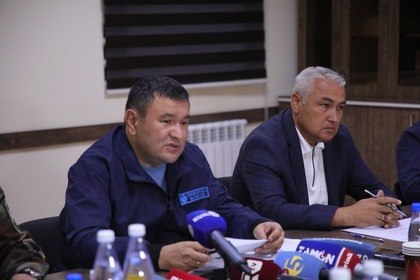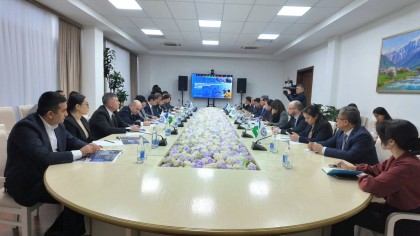On the evening of September 18, the Minister of Energy Jurabek Mirzamakhmudov and the Minister of Emergency Situations, Major General Abdulla Kuldashev spoke at a briefing in the Baysun district of the Surkhandarya province, where they spoke about the accident at the well of the 25 Years of Independence gas field (M-25).
Recall that on September 1, during drilling operations at the 604th well of the field, a hydrogen sulfide leak occurred. Local residents were evacuated. Work to eliminate the accident continued for two weeks. On September 15, the leak was stopped. However, two days later the leak resumed, 4 people died and 11 were injured.
On the "complicated" field
The Minister Mirzamakhmudov began his speech with the history and features of the "complicated" gas field, which is located in the foothills. The absolute height of the relief is 1000 meters above sea level.
The field, which was called "Gajak", was first discovered by geologists in 1933. In 1941, the first exploratory well was drilled here. In 1974, during the testing of the 5th well, industrial gas flows were obtained, as a result of which the object was included in the category of fields.
According to preliminary estimates, gas reserves at the field were estimated at 40 BCM. In 2006-2008, the Malaysian oil and gas company Petronas, as part of a joint study with Uzbekneftegaz, conducted 3D seismic exploration at the Gajak area and tested one well.
The company's direct investment in the project amounted to $ 102 million. However, due to "geopolitical events" and a change in the company's investment policy, as well as the of developing of the complicated field, the company withdrew from the project, said Zhurabek Mirzamakhmudov.
The Minister stated that the media "misinterpret" the situation when talking about a hydrogen sulfide leak. According to him, this is a leak of natural gas with a high content of hydrogen sulfide (7%) and carbon dioxide (12%), in connection with which a plant for gas purification and separation of carbon dioxide from it is being built as part of the project.
According to the Ministry of Energy, the M-25 field, according to its geological structure, belongs to the category of "very complicated mining and geological conditions" and "hard-to-recover reserves".
The initial reserves confirmed in the gas processing complicated are estimated at 108.6 BCM. At the same time, over the production period (30 years), the accumulated gas production is expected to be 81.2 BCM, and the extraction factor should be 0.77.
Azizbek Nazarov, adviser to Eriell CEO, Bakhtiyor Fazilov, underscored that additional geological exploration revealed reserves of another 60 BCM, meaning that the total reserves are estimated at 170 BCM of gas. "This is the largest untouched and unused gas field in Uzbekistan," he said.
The gas consists of hydrogen sulfide (up to 7%) and carbon dioxide (up to 12%). The field has abnormally high reservoir pressure (65 MPa), and the temperature along the section is up to 150 degrees Celsius.
For comparison: at the Mubarek fields, the hydrogen sulfide content is up to 3.8%, carbon dioxide - up to 4.61%, in the Ustyurt area - 0% and up to 1.31%, in the Shurtan district - 0.07% and 9%, in the Gazli area - 0.72% and up to 3.1%, respectively.
“This means that there are almost no such complicated fields in Uzbekistan. Of course, all this was taken into account. To date, more than 20 wells have been drilled using the most modern technological solutions and the most modern technological equipment,” the Minister of Energy said.
These conditions require the use of special equipment, materials, chemical reagents and technologies that ensure resistance to high pressure, temperature and exposure to hydrogen sulfide. High-density drilling fluids (up to 2.3 g / cm3) are also needed to cope with “hydrocarbon aggression”. A special approach is required to manage drilling fluids, given the complicated geomechanics of the field.
While, the reservoir conditions, temperature and pressure conditions and the presence of carbon dioxide and hydrogen sulfide in the reservoir fluid require the use of expensive equipment and materials made of corrosion-resistant CRA alloys (nickel-chromium-molybdenum) capable of operating in aggressive acidic environments at high temperatures and pressures. This was confirmed by the project's international technical consultants (Halliburton, Schlumberger, Baker Hughes, Weatherford and others), the press service of the Ministry of Energy underscored.
During well testing, sulfur deposits were also observed in the tubing pipes, to eliminate which it is necessary to introduce chemical reagents capable of dissolving sulfur plugs.














